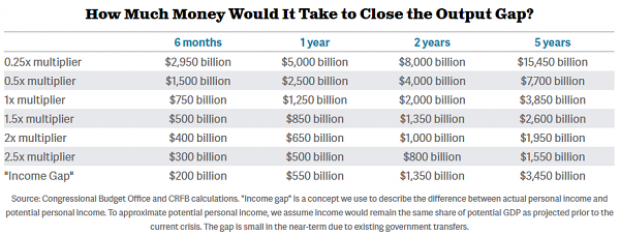The coronavirus crisis will likely depress the economy for years to come, reducing output by trillions of dollars. According to a new analysis by the Committee for a Responsible Federal Budget, under current law the output gap — defined as the difference between actual output and the potential output produced by an economy firing on all cylinders — will total $750 billion over the next six months, and $2 trillion over the next two years.
The next stimulus package can help close that gap, CRFB says, and policymakers should consider how effective their spending plans would be with respect to boosting output. Much depends on the multiplier effect of different kinds of spending, with some outlays having a more powerful effect on output than others. A dollar of spending on unemployment benefits, for example, might produce as much as $1.90 in economic activity, while a dollar of spending on aid to states might produce as little as 40 cents.
Using estimates from the Congressional Budget Office, CRFB runs through various scenarios showing how much federal spending would be required to close the output given different multiplier effects.
“For example, with a fiscal multiplier of 1.5 it would take $500 billion to close to output gap over the next six months, $850 billion to close it over the next year, and $1.4 trillion over two years,” CRFB says. “In contrast, with a 0.5 multiplier, it would take $1.5 trillion of funding to close the output gap over the next six months, $2.5 trillion to close it over the next year, and $4 trillion to close it over the next two years.”
Alternatively, policymakers could target personal incomes rather than overall economic output. The cost of making up for lost incomes via direct transfers would come to about $200 billion over six months and $1.4 trillion over two years, CRFB says.





